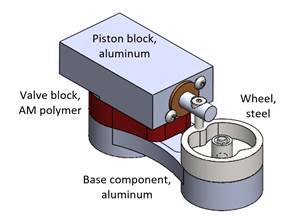Lighted Workstop Verifies Part Location
Electrifying the work allows a light to indicate whether the setup is correct. The simple solution turned into a standard product for this shop.
Share






During setup, just the turn of a screw can make the difference between a sellable part and a scrapped one. A part that locates accurately can shift out of tolerance with the last twist of the screw that clamps it. The operator might not know this has happened until after the part is machined and fails inspection.
R&R Tool experienced this. The contract manufacturer in Blanchester, Ohio, specializes in precision medical components. A particularly challenging small and flexible part required an angled surface to locate with respect to a hole at the other end of the workpiece. This part might locate accurately against a workstop at first, but then was prone to shift invisibly during clamping. R&R had to find a way to reliably ensure that every clamping was accurate, without having to rely on tedious measurement, re-clamping and re-measurement for each setup of this part.
The solution that R&R hit upon was to electrify the workstop.
After all, the part was conductive. An accurate setup would therefore close a circuit—with a light indicating that this contact was made. The actual light the shop has been using is blue ... but seeing this light gives operators the green light to begin machining.
Shop owner Dan Reed says the solution has been so effective and so useful, his shop has begun using it as a routine element of making other parts as well. In addition, the shop has begun marketing the product. R&R now manufacturers and ships a self-contained version powered by AA batteries. The trade name is the “Lightnin’ Rod.” Various other shops have already found this new product and begun to use it.
A photo at right shows the Lightnin’ Rod being used on another R&R part. The components are machined four at a time out of two solid blocks. When the blocks gets small, the operator uses supports to raise them up out of the vise to get more pieces. Each of these new clampings creates an opportunity for error. The stock shifting by a few thousandths during clamping or during machining can cause a component to be scrapped. With the charged workstop, though, the stock must be within 0.0005 inch of the workstop for the light to activate. Therefore, the operator only has to see that the light is on for each vise prior to machining, and still on after the machining is complete. If so, then the parts are good.
“This is all about getting away from relying on the ‘feel’ of skilled machinists,” Mr. Reed says. In the past, the employee setting up this part would use a 0.002-inch shim to check that the work was close to the stop. However, there are problems with this approach. That “feel” is subjective, and investigating the setup in this way adds time to the process. Worst of all, the skilled employees who possess this kind of reliable feel are becoming scarce. The new process makes it possible to rely on less experienced employees for these parts, with the light serving as a concrete go/no-go gage for each setup. Mr. Reed says the shop is currently developing a variation on the Lightnin’ Rod that will work for non-conductive workpieces as well.
Related Content
Addressing the Manufacturing Labor Shortage Needs to Start Here
Student-run businesses focused on technical training for the trades are taking root across the U.S. Can we — should we — leverage their regional successes into a nationwide platform?
Read MoreThe Power of Practical Demonstrations and Projects
Practical work has served Bridgerland Technical College both in preparing its current students for manufacturing jobs and in appealing to new generations of potential machinists.
Read MoreSolve Worker Shortages With ACE Workforce Development
The America’s Cutting Edge (ACE) program is addressing the current shortage in trained and available workers by offering no-cost online and in-person training opportunities in CNC machining and metrology.
Read MoreHow I Made It: Amy Skrzypczak, CNC Machinist, Westminster Tool
At just 28 years old, Amy Skrzypczak is already logging her ninth year as a CNC machinist. While during high school Skrzypczak may not have guessed that she’d soon be running an electrical discharge machining (EDM) department, after attending her local community college she found a home among the “misfits” at Westminster Tool. Today, she oversees the company’s wire EDM operations and feels grateful to have avoided more well-worn career paths.
Read MoreRead Next
Machine Shop MBA
Making Chips and 91ÊÓƵÍøÕ¾ÎÛ are teaming up for a new podcast series called Machine Shop MBA—designed to help manufacturers measure their success against the industry’s best. Through the lens of the Top Shops benchmarking program, the series explores the KPIs that set high-performing shops apart, from machine utilization and first-pass yield to employee engagement and revenue per employee.
Read MoreAMRs Are Moving Into Manufacturing: 4 Considerations for Implementation
AMRs can provide a flexible, easy-to-use automation platform so long as manufacturers choose a suitable task and prepare their facilities.
Read More




















